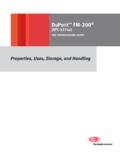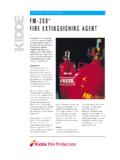Transcription of Read more at http://www.argonite.com/
1 Welcome to Argonite fire protection from Ginge-Kerr Looking for fire protection of high value areas? Then you've come to the right place. As halon systems go out, the Argonite system is coming in. All the essential facts about this natural alternative are right here. See how it works, why it works, where it works. Read more at The natural alternative to halon 1301. Ginge-Kerr has developed the Argonite system as a viable but environmentally friendly alternative to halon . Tested and approved by regulatory bodies throughout the world, Argonite is effective against fires in almost all combustible materials and is particularly suitable for use in areas where the use of water, foam or powder would be unacceptable. Ideal for protecting high value areas Argonite systems are ideally suited to the protection of fixed equipment and plant. They are particularly applicable for high value risks where fires can have devastating consequences way beyond the cost of damage and lost production.
2 Applications include: Computer suites Telecommunications facilities Archive stores Control centres Fast acting and effective against nearly all fire hazards Environmentally neutral - zero ODP, zero GWP. Low installation and maintenance costs No post-fire residues or damage to protected equipment Electrically non-conductive Safe for occupied areas Can be integrated with existing detection and alarm systems Automatic or manual release Total flooding or modular design Minimum downtime after a fire A dedicated, flexible solution In a closed space almost all fires are extinguished in less than 60 seconds when the oxygen concentration falls below 15%. The Argonite fire extinguishing system, based on a mixture of 50% Nitrogen and 50%. Argon, reduces the oxygen concentration to - a level acceptable to human exposure over short periods - thus eliminating the fire quickly and effectively without affecting personnel.
3 Knowing the size and complexity of the area to be protected, the fire hazard present and the requirements of the local approving authority, a dedicated computer program is used to specify the size and geometry of the Argonite system hardware. Generally one of two methods is used to protect an area with Argonite. These are total flooding, where the required amount of gas is released into a room, and modular or local systems that are designed to cover an particular piece of enclosed machinery, equipment, etc. Efficient, cost-efficient protection Argonite systems consist of one or more pressure cylinders connected via a common manifold. System actuation can be manual or automatic and the gas is dispersed through a pipe network and enters the protected area via nozzles. Valve design, the size and pressure of the cylinders, used together with computer calculated pipe and nozzle dimensions, ensure that the correct amount of Argonite is released effectively.
4 Argonite's inerting and extinguishing properties act quickly to eliminate the fire. If more than one area within a building is to be protected, a single Argonite system, designed to extinguish a fire in the largest room, can be used. Provided that there is no risk of more than one fire within the facility at any one time, the total cost of the fire protection system can be reduced significantly in this way. Designed to ensure maximum cost effectiveness A range of cylinders is available offering a choice of fill capacities and pressures to ensure maximum cost effectiveness of the installation. Each cylinder is manufactured from high strength alloy steel and is supplied in accordance with the requirements of the various national authorities - inclusive of stamping and certification. They are mounted in rows and may be installed in any suitable location. Since the introduction of Inert Gas systems, the most common storage pressure has been (150 and) 200.
5 Bar. Recently, a new Argonite 300 bar system has been developed, which requires around 30% less storage space than previously and saves considerable time on installation and maintenance. Comparison btw. 200 & 300 bar 200 bar 300 bar Cylinder capacity / L 15,9 67,5 80 15,9 67,5 80. Argonite capacity / m 3,1 13,2 15,8 4,4 18,7 22,1. Argonite filling / kg 4,4 18,7 22,2 6,2 26,4 31,3. Weight empty incl. valve / kg 25,7 75,2 85,2 25,7 110,2 118-126. Weight filled / kg 30,2 94,4 108 31,9 136,6 149-158. Diameter / mm 204 267 267 204 267 267. Height incl. valve / mm 795 1605 1860 825 1680 1935. Nominal protected volume / m *) 6,1 25,8 30,6 8,6 36,4 43,1. Nominal protected volume / m **) 7,6 32,3 38,3 10,7 45,6 54. *) Cylinder/volume ratio, class A & C fires according to ISO 14520-1114. **) Cylinder/volume ratio, class A & C fires according to NFPA 2001. Choice of actuation methods Made of corrosion resistant brass, Ginge -Kerr's Argonite valves are designed to ensure optimum system performance, reduced pipe sizes and low installation costs.
6 They can be actuated by one of the following methods: Solenoid Pneumatic Local manual release at control head Country Approvals, Verifications, Listings & Acceptances Bahrain Civil Defence and Fire Service Directorate Denmark Danish Institute of Fire Technology Danish Working Environment Service Finland Finnish Insurance Association France Ministere des Affaires Sociales de la Sante Ministere de l'Environment CNPP. Germany Hygiene-Institut Landsfeuerwehrschule / Nordrhein- Westfalen Greece Greek Fire Brigade Hungary Ministry of Interior Fire Fighting Investigation Laboratory Iceland Icelandic Maritime Administration Japan Fire protection equipment and safety center Latvia Fire Rescue Department Netherlands TNO-Voeding Norway Det Norske Veritas Poland CNBOP. Sweden Insurance Association Switzerland Sicherheitsinstitutes Z rich United Kingdom LPCB. halon Alternatives Group USA Environmental Protection Agency NFPA 2001.
7 HARC. Question: What does Argonite consist of and why? Answer: Argonite is a composite gas that consists of 50% Nitrogen and 50% Argon. The gas is mixed and stored under pressure. The composite is completely inactive and is not involved in the burning process. In consequence, extinguishing th e fire does not pose any risk of producing toxic fission products. The gas simply reduces the oxygen level from down to thus quenching the fire. Both nitrogen and argon work as oxygen-displacing elements, and argon is mainly added to achieve a specific gravity (almost). equal to that of ordinary air. Question: What is the price of an Argonite fire extinguishing system? Answer: The price of an Argonite system primarily depends on the size of the room that needs protection. All Argonite systems are specially designed to meet the needs of each individual customer. For a specific estimate simply contact your nearest Argonite distributor.
8 In comparison to halon and other chemical alternatives (the) Argonite (gas) is relatively inexpensive, which makes a refill of an Argonite system equally inexpensive. Question: Is Argonite approved? Answer: Yes - Argonite is approved and/or (verified) by most international authorities and since 1993 more than 15,000 Argonite systems have been installed world-wide. Question: How much space does an Argonite system take up? Answer: The size of an Argonite system depends on the size of the room that needs protection. The advantage of an Argonite system compared to ( halon systems)is that it can be placed outside the protected room and even at a relative distance from this room. It can be placed wherever there is some vacant space - in a basement or on the next floor. Question: Is Argonite safe for personnel? Answer: Yes - in accordance with international standards Argonite can be used in a manned (areas).
9 Argonite reduces the level of oxygen to - which is humanly sustainable for a short period of time. Question: If converting from halon to an Argonite system how much of the existing system can be reused? Answer: In most cases all electrical, (detection) detective and controlling equipment of reasonably up-to- date standard (less than 10 years old) can be reused. halon containers, pipes and nozzles are always (needs to be) replaced with Argonite system parts.









